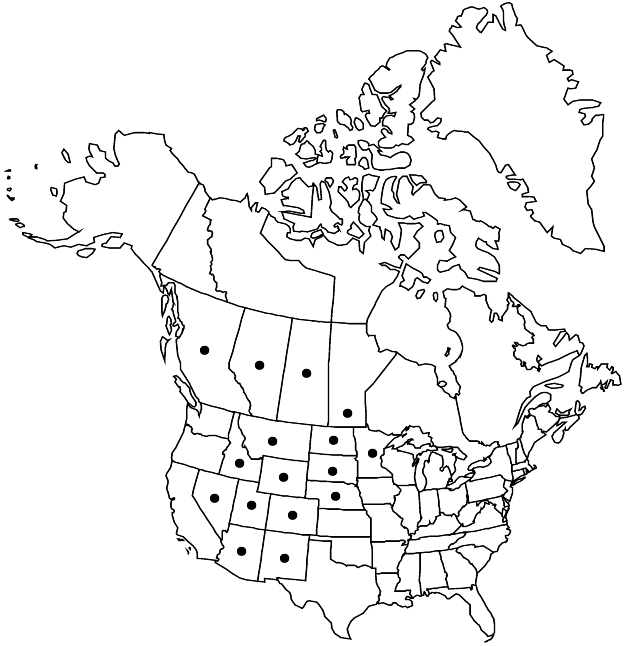Difference between revisions of "Silene drummondii"
Fl. Bor.-Amer. 1: 89. 1830.
FNA>Volume Importer |
FNA>Volume Importer |
||
| Line 34: | Line 34: | ||
|distribution=c;w North America. | |distribution=c;w North America. | ||
|discussion=<p>Subspecies 2 (2 in the flora).</p><!-- | |discussion=<p>Subspecies 2 (2 in the flora).</p><!-- | ||
| − | --><p>Subspecies drummondii is characteristically a prairie taxon, while <i></i>subsp.<i> striata</i> is associated with the Rocky Mountains. However, the two taxa frequently appear to intergrade; e.g., in the Cypress Hills of southern Alberta and Saskatchewan, and in the southern Rockies. Variety kruckebergii appears to be a luxuriant form with a more elongate capsule and calyx. <i>Silene invisa</i>, a Californian species, is similar to <i>S. drummondii</i>, some plants of which, from <i>Nevada</i> and Arizona, tend to be intermediate (see note under <i>S. invisa</i>).</p> | + | --><p>Subspecies drummondii is characteristically a prairie taxon, while <i></i></i>subsp.<i><i> striata</i> is associated with the Rocky Mountains. However, the two taxa frequently appear to intergrade; e.g., in the Cypress Hills of southern Alberta and Saskatchewan, and in the southern Rockies. Variety kruckebergii appears to be a luxuriant form with a more elongate capsule and calyx. <i>Silene invisa</i>, a Californian species, is similar to <i>S. drummondii</i>, some plants of which, from <i>Nevada</i> and Arizona, tend to be intermediate (see note under <i>S. invisa</i>).</p> |
|tables= | |tables= | ||
|references= | |references= | ||
| Line 69: | Line 69: | ||
|publication year=1830 | |publication year=1830 | ||
|special status= | |special status= | ||
| − | |source xml=https://jpend@bitbucket.org/aafc-mbb/fna-data-curation.git/src/ | + | |source xml=https://jpend@bitbucket.org/aafc-mbb/fna-data-curation.git/src/f6b125a955440c0872999024f038d74684f65921/coarse_grained_fna_xml/V5/V5_369.xml |
|subfamily=Caryophyllaceae subfam. Caryophylloideae | |subfamily=Caryophyllaceae subfam. Caryophylloideae | ||
|genus=Silene | |genus=Silene | ||
Revision as of 21:08, 24 September 2019
Plants perennial; taproot stout; caudex branched, somewhat fleshy. Stems erect, simple or several from base, retrorsely puberulent proximally, densely so and viscid distally, with stipitate glands. Leaves: blade with stiff, appressed pubescence on both surfaces; basal petiolate, blade lanceolate to elliptic or oblanceolate, (1.5–)3–10 cm × 4–12 mm (including petiole); cauline in 2–5 pairs, blade linear to linear-lanceolate, 3–9 cm × 2–7 mm. Inflorescences 1–20-flowered, bracteate, strongly viscid-glandular or less densely pubescent, longer hairs sometimes purple-septate; bracts narrowly lanceolate, thick, 3–15 mm, herbaceous, apex acuminate. Pedicels stiffly erect, 0.1–5 cm, varying in length within same inflorescence. Flowers: calyx 10-veined, broadly tubular to narrowly ellipsoid, not inflated, 12–18 × 4–8 mm in fruit, 2–3 times as long as broad, membranous between veins, margins dentate with 5 triangular, 1.2–2 mm lobes erect in flower and spreading in fruit, apex acuminate, veins green; petals off-white to dusky pink or dingy reddish purple, clawed, equaling or to 11/2 times calyx, claw broadened distally, limb not differentiated from claw, narrower than claw, 1–3 mm; stamens included in calyx; styles (4–)5, included in calyx. Capsules 12–15 mm, equaling calyx (rarely to 11/2 times calyx), opening by (4–)5 spreading teeth. Seeds dark brown, not winged, reniform to angular, 0.7–1 mm diam., margins finely papillate; papillae triangular, slender, longer than broad.
Distribution

c, w North America.
Discussion
Subspecies 2 (2 in the flora).
Subspecies drummondii is characteristically a prairie taxon, while subsp. striata is associated with the Rocky Mountains. However, the two taxa frequently appear to intergrade; e.g., in the Cypress Hills of southern Alberta and Saskatchewan, and in the southern Rockies. Variety kruckebergii appears to be a luxuriant form with a more elongate capsule and calyx. Silene invisa, a Californian species, is similar to S. drummondii, some plants of which, from Nevada and Arizona, tend to be intermediate (see note under S. invisa).
Selected References
None.
Key
| 1 | Petals equaling calyx; fruiting calyces 12-15 × 4-6 mm, 21/ 4-3 times as long as broad; seeds ca. 0.7 mm diam.; inflorescences typically (1-)3-10(-20)-flowered | Silene drummondii subsp. drummondii |
| 1 | Petals 11/ 1/ 2 times calyx and clearly exserted from it; fruiting calyces 13-18 × 6-8 mm, ca. 2 times as long as broad; seeds ca. 1 mm diam.; inflorescences typically 1-4(-8)-flowered | Silene drummondii subsp. striata |